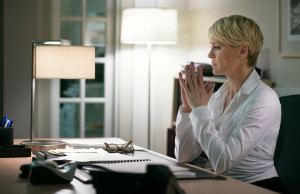
By: Aaron Warnick | Photo Editor
House of Cards season two will hit you harder than a D.C. metro subway car bearing down the tracks at full-speed … and while that analogy may elicit an emotional response from those who have already indulged in a few hours of the new Netflix offering, it’s as close to a spoiler as you’ll get from me. So read fearlessly on, because even if I were to ruin the conclusion of season two, the storyline unfolds in such a way that you wouldn’t believe me until the very end anyway.
The first 13 chapters of House of Cards follow Francis Underwood, the U.S. House of Representatives Majority Whip, hell-bent on ascending to the executive branch of the government. Francis, or Frank, uses subterfuge, sabotage and murder to eventually manipulate his way into becoming the vice president of the United States.
Netflix signed House of Cards as a two season project, so the story was planned to have perfect continuity. The world is the stage and, with the stakes so high, there is little time left for side-plots. There are no random trips to the home district nor any homoerotic college gatherings. The aforementioned ‘throwaway episodes’ allow the action to start and stop in season one. The pace of the new chapters of House of Cards give you no place for a bookmark. Season two begins at Chapter 14 and demands your attention until the screen goes black at Chapter 26.
There is no rest for the wicked.
The new season begins with the power-couple on the jog that they started at the end of last season. Kevin Spacey returns as the newly named vice president Francis Underwood. With a Golden Globe Award in her back pocket from season one, Robin Wright jogs next to Spacey as independently powerful Claire Underwood. The supporting cast that survived the first season returned intact for the next batch of chapters. However, as the Underwoods rise to power, they spend more time sharing the frame with the more powerful characters from season one, like President Garret Walker (played by Michel Gill) and multi-billionaire investor Raymond Tusk (played by Gerald McRaney).
When Frank Underwood stares into the camera for the first time to shatter the fourth wall and says, “for those of us climbing to the top of the food chain, there is but one rule: hunt or be hunted.”
In season one, Frank Underwood was a ruthless tactician who lined-up pieces and perfectly knocked them back down. It was one of shortcomings of the first season. However, in season two, he encounters rivals just as vicious as himself. House of Cards protagonist with a few vices, but to adore a meticulously malevolent villain who will attempt to destroy anything that stands in his path.
House of Cards relies heavily on an audience that values self-determination. Frank Underwood is the darkest hero in television today, arguably to date. In his quest for domination, Frank manipulates the press, toys with the economy and even defiles the democratic process. Frank Underwood is a villain doubling as the protagonist. House of Cards lacks “the good guy” because anyone who limits him or herself within a moral framework is easily eliminated.
Claire Underwood, while sometimes equally as ruthless, provides a more likeable protagonist. She quickly proves that she can be just as amoral as Frank. In Chapter 14, she says to a pregnant former-employee that she will “let your child wither and die inside of you if that’s required” if she refuses to drop a lawsuit. But Claire does not just use her resolve to further her own causes. She uses her power to publicly confront women’s issues like abortion and rape. Further separating herself from Frank, Claire shows signs of humanity as she finds her moral limits in season two. However, her breakdown makes Claire the stronger character in this power-couple.
While the quick paced action of House of Cards sounds more like an action movie than a political-thriller drama, Frank’s rampage for power is placed in a masterfully cinematic frame. Almost every single scene is a tribute to compositional rules. The art never proceeds the story, though, and the artistic filming of House of Cards never once imposes itself on the viewer.
Netflix does not release their viewership statistics, but if the talk around the watercooler (or Starbucks line, if we’re being accurate to our readership) is any indication, season two is a hit. Fans are raving and early reviews are just as satisfied. With an excellent story, award-winning acting and cinematography, House of Cards is on top of television right now, an impressive feat for a show that isn’t actually on television.
